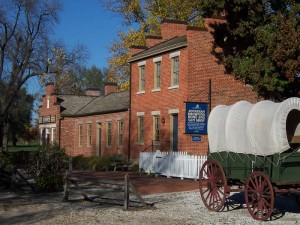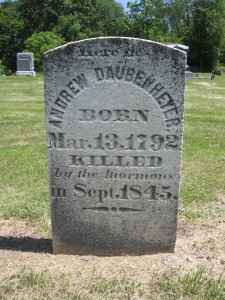 Nauvoo, Illinois, the city the Mormons built, was thriving and growing in the 1840s. The population was such that Nauvoo rivaled Chicago for “biggest city in Illinois.” Most visitors to today’s restoration of historic Nauvoo will learn that fact, perhaps from several different Mormon tour guides. One statistical comparison that isn’t mentioned, however, is that in the fall of 1845, Nauvoo’s violent crime rate very likely surpassed that of Chicago.
Nauvoo, Illinois, the city the Mormons built, was thriving and growing in the 1840s. The population was such that Nauvoo rivaled Chicago for “biggest city in Illinois.” Most visitors to today’s restoration of historic Nauvoo will learn that fact, perhaps from several different Mormon tour guides. One statistical comparison that isn’t mentioned, however, is that in the fall of 1845, Nauvoo’s violent crime rate very likely surpassed that of Chicago.
In 1845, crime in Chicago was such that the city had only four men responsible for keeping the peace: one marshal and three assistants; whereas the Nauvoo police force, in January of 1845, numbered 500 men. While there were extenuating circumstances in Nauvoo necessitating a high number of peacekeepers, in the fall of 1845 Nauvoo’s policemen were often the source of violent crime.
In his book, One Nation Under Gods, Richard Abanes details some of these events from September and October of 1845. He writes,
“A halt to the violent conflict between Mormons and anti-Mormons lasted but a brief period of time after Smith was killed. Armed mobs of Illinoisans, incited by endless newspaper articles covering Mormon issues, soon began to conduct raids against isolated church settlements. Saints were threatened, LDS homes were burned, rumors about various Mormon atrocities circulated, and militias were called out by the governor. Church dissenters and critics, meanwhile, continued to expose aspects of Mormonism that church leaders did not want revealed. The Saints retaliated with verbal intimidation, religious condemnation, and acts of physical violence… More disturbing were the many murders, vicious beatings, and intimidating assaults perpetrated by the Nauvoo police against perceived enemies of the church. Policeman Alan J. Stout summed up the rational of the Saints on these matters, explaining that to his mind such activity was nothing more than avenging the blood of Joseph and Hyrum. In reference to the Mormon dissenters remaining in Nauvoo, Stout expressed a common sentiment: ‘I feel like cutting their throats.’” (210-211)
Mr. Abanes continues his narrative by describing specific acts of violence perpetrated by the police and other Mormon enforcers during 1845. Using Mr. Abanes’ book (and consulting a few others), I here list ten of these violent crimes from September 1845.
- On September 14, the Nauvoo police had three men flogged because they were not in good fellowship with the church.
- Frank Worrell, a Carthage Jail guard who failed to protect Joseph Smith, was murdered on September 16, shot out of his saddle by Porter Rockwell.
- Rockwell also killed four unnamed “anti-Mormons” at Highland Branch, near Warsaw, on September 16.
- Again on September 16, suspected spy Phineas Wilcox disappeared in Nauvoo, having been last seen as he was led toward the Masonic Hall by three Mormons. Wilcox’s stepfather, Orrin Rhodes, inquired after him and searched for him for a week, finally concluding, “Wilcox has been murdered by…Mormons.” (See Hallwas and Launius, Cultures in Conflict, 278-280)
 Andrew Daubenheyer disappeared on the road to Carthage on September 18. He was later found buried in a shallow gave near a campsite on the Carthage road “with a musket ball through the back of his head” (See Cultures in Conflict, 279). In due time Daubenheyer was given a proper burial with a headstone that reads, “Killed by the Mormons.”
Andrew Daubenheyer disappeared on the road to Carthage on September 18. He was later found buried in a shallow gave near a campsite on the Carthage road “with a musket ball through the back of his head” (See Cultures in Conflict, 279). In due time Daubenheyer was given a proper burial with a headstone that reads, “Killed by the Mormons.”- Later in September, “several Saints captured a young man by the name of McBracking” who was accused of burning Mormon homes. McBracking’s friends found his body the next day and reported, “After shooting him in two or three places, they cut his throat from ear to ear, stabbed him through the heart, cut off one ear & horribly mutilated other parts of his body.”
- Mormon apostles Heber C. Kimball and Orson Hyde ordered the killing of apostate Lambert Symes, who subsequently “disappeared without a trace.”
Nauvoo’s bloody autumn of 1845 could have been much worse, but as it was, it clearly demonstrated that the Mormons and non-Mormons of Hancock County would never learn to live together in peace. “Therefore,” wrote Brigham Young, “we propose to leave this county next spring, for some point so remote, that there will not need to be a difficulty with the people and ourselves…” The following February the Saints began their long journey to Utah Territory; and though the territory was remote, difficulties between Mormons and non-Mormons did not cease for long.

I could write a book on how the Mormons have treated me from 2004 till now when i was in the church and now out the last 4. It is so much better being out of the church then when i was in. In fighting within the church is brutal. But if u have left u can be sure that they keep a eye on u always.
Mormon children grow up hearing from their parents and church leaders about how Mormons were persecuted greatly for their faith , and this forms an important part of the mindset of being a Mormon .It seems though that there is more to this issue than what most Mormons hear . Not all of the violence that Mormons themselves committed was because of self defense , and that is something that has been kept quiet in Mormon Wards and by Mormon missionaries for a long time . But information about this has been coming out and being better disseminated publically in recent years .
Mormonism has been very polished at creating it’s public image . The issue of persecution in it’s history is but another example of how Mormonism uses half truths in presenting it’s image and also it’s message .
The Mormon people deserve to know the truth — about their history , and about the true gospel .
This has absolutely nothing to do with Nauvoo but I think it demonstrates the “zeitgeist” the spirit of the time; general trend of thought or feeling characteristic of a particular period of time
that existed in the 19th century America. I visited Virginia City, Montana a few years back and found the history more than a little interesting. People of this era were quite violent and some would say, uncivilized. But their motivation was to stop those who they saw as being lawless or undesirable.
“In the first two months of 1864, the Montana vigilantes hanged 24 men, including Plummer (the town sheriff). Most historians agree that these hangings, while technically illegal, punished only genuinely guilty men. However, the vigilantes’ decision to hang Jack Slade seems less justified. Finally fed up with his drunken rampages and wild threats, on this day in 1864 a group of vigilantes took Slade into custody and told him he would be hanged. Slade, who had committed no serious crime in Virginia City, pleaded for his life, or at least a chance to say goodbye to his beloved wife. Before Slade’s wife arrived, the vigilantes hanged him.”
So I think before Mormons begin to charge “persecution” they need to take a closer look at what was going on in our country during that time period.
Interesting fact about Nauvoo:
The heritage of violence in Nauvoo, Illinois, reached into the Twentieth Century, long after the murder of Joseph Smith and the revenge killings. In fact, there’s a “Nauvoo Connection” to the notorious gangster Al Capone:
“During prohibition, Nauvoo was the largest producer of wine in America and Al Capone would boot-leg wine from Nauvoo into Chicago.”
https://www.facebook.com/WillardRichardsInn
Buff,
Capone had a hide out in Wisconsin, just north east of where I live. I’ve visited it. Didn’t spot any Mormons. Did eat at the restaurant and took the tour. It’s been years though.
https://www.google.com/search?q=al+capone%27s+wisconsin+hideout&tbm=isch&tbo=u&source=univ&sa=X&ved=0CEQQsARqFQoTCPLU0u7MrMgCFY86iAodqwsEUg&biw=1320&bih=701
Wow! Now thats’ ironic!
Most people try to get OUT of Wisconsin, like those Wisconsin lawmakers back in 2011 who fled Wisconsin and hid out in Illinois so they wouldn’t have to vote in Wisconsin.
http://abcnews.go.com/Politics/wisconsin-democrats-hiding-face-legal-political-consequences/story?id=12972163
(Actually, I think that was just an excuse so they could slip out of Wisconsin and party in Nauvoo…)
Now, I’m not saying Wisconsin is boring, but when your football fans are referred to as cheeseheads, I really think that says something about the state… Just kidding! …I think…
It’s kind of ironic that anyone would flee TO Wisconsin. I understand that most people are trying desperately to get OUT of Wisconsin, like those Wisconsin lawmakers who hid out in Illinois in 2011 so they wouldn’t have to vote in Wisconsin.
http://abcnews.go.com/Politics/wisconsin-democrats-hiding-face-legal-political-consequences/story?id=12972163
Frankly, I think they were just looking for an excuse to party in Nauvoo…
Now, I’m not saying Wisconsin is boring but when your football fans refer to themselves as “cheeseheads” I think that speaks volumes about the rowdiness factor in the state…
Just kidding! …I think…
oops. My mistake. A bad case of “stutter-thumb”…
One thing though, beware of Richard Abanes, hr isn’t as much as a Christian apologist as he is Rick Warren’s clean-up man for when Warren says something un-Biblical, which is often.
Turns out he, Warren, and the LDS have a similar goal: erasing the theological divide between Mormonism and popular Christianity. Some info here: http://truedsicernment.com/2008/03/15/rick-warren-apologist-richard-abanes-going-soft-on-mormonism-is-this-the-direction-rick-warren-is-heading/
I’m wondering when our country might turn to violence in regards to religious matters. When I saw the Planned Parenthood videos of them discussing how to profit from selling the body parts of aborted babies I asked myself, “Have we reached the point where some might feel totally justified in turning to violence to stop this?”
I came through the Vietnam War period as a college student. I remember the Weathermen Underground and other such groups that felt perfectly justified in using violence. What sort of ended it was when the Math Research Center in Madison, WI was blown up in the middle of the night and an innocent researcher was killed in the explosion. One of the perps is still at large forty-plus years later.
I was just watching a documentary on the Civil War that discussed John Brown’s attack on the Federal Arsenal at Harper’s Ferry. Brown justified the violence based on his righteous opposition to slavery. He was hanged of course for his efforts but he was immortalized by many who held his views.
So the back-and-forth that was going on with the Mormons is typical(?). The Mountain Meadows Massacre was one such Mormon perpetrated mass murder against innocent people. The Mormon claim of persecution needs to be viewed in the larger context of what was going on.
Falcon —
Since you mentioned the Mountain Meadows Massacre, it’s worth mentioning that the Mormon Church hid and protected the chief perpetrator for 20 years after the massacre, and prohibited members of the Church from mentioning the event. Only when left with no other option did the Church turn John D. Lee over to the authorities. Even today, though, the Church refuses to accept responsibility for any part of the massacre or the cover-up.
That must be what Apostle Dallin Oaks means when he says the Church doesn’t apologize for anything to anyone.
http://www.sltrib.com/lifestyle/faith/2122123-155/no-apology-really-mormons-question-apostle